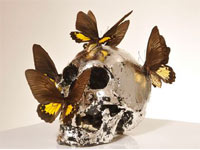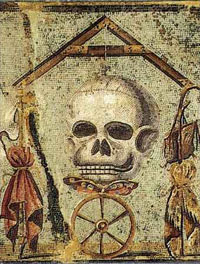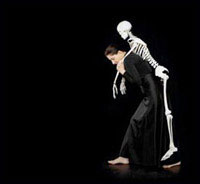Cracking skulls!
by Laura Angela Bagnetto
Article published on the 2010-02-14 Latest update 2010-02-15 12:35 TU
Fascination with death reaches new heights in an exhibition guaranteed to make you touch your head and feel thankful it is not made out of colouring crayons, or flies! At the Maillol museum in Paris, death and life mingle as museum-goers line up for C'est la Vie! Vanités, an unusual exhibition on skulls in painting, objets d'art, books, multimedia, photography and jewellery throughout the ages.
Culture in France: Death becomes a hot new exhibit
Once used as grisly reminders that you are going to die, or a Memento Mori, skull images are now as ubiquitous on children’s clothing as they were in Jesuit-inspired art of the 16th and 17th centuries.
While their presence has waxed and waned over the ages, skull iconography remains strong in the 21st century.
Skulls were originally portrayed as metaphysical symbols in early Rome, but later they morphed into physical symbols, and then political statements.
“When Christianity started to decrease, the subject matter kind of decreased as well,” explains Loic Malle, an art historian who helped put the C'est la Vie! Vanités exhibition together. “During the 19th century - it was a very dramatic century - skulls again came into fashion.”
“Little by the little, the skull loses its metaphysical power. It’s really about death physically,” he adds.
One of the earliest use of skulls as a visual is found around ancient Rome. Romans believed either stoicism (prepare yourself, you’re going to die) or the idea of 'carpe diem' (you're going to die anyway, so seize the day and have fun while you're here).
The oldest piece in the exhibition is a Memento Mori, a colour mosaic made of tiny tesserae with a skull featured prominently in the middle, originally the centre of a table.
"It says, 'enjoy life doing whatever: drinking, eating, making love maybe’, but at the same time it is a kind of lesson of philosophy,” says Malle. “If you look carefully under the skull, you have a little butterfly, which is the fragility of life. and then you have a wheel underneath, which is destiny, your future, it changes all the time.”
Skull imagery disappeared until the Middle Ages, when the impact of fatal diseases like the plague brought it back.
It was not as important during the renaissance, when Christianity waned, but the Jesuits brought the skull back in full force in the 16th century. Caravaggio painted one of his master works, St. Francis in Prayer in 1602, a piece featured in the exhibit.
Symbolism also factors into many of these works. Four 17th century still-life vanity paintings show a skull surrounded by objects, including cards, which refers to the ‘game of life.’
Birds are fragile creatures, and feathers reflect this. Plants and flowers die quite quickly, while a smoking pipe, which at that time was made of terra cotta, shows how life can break easily, explains Malle.
In one painting a violin is featured, "because sound is very ephemeral,” he says.
Prominently displayed among the 17th century still-lifes is Untitled (1992), a photography by Cindy Sherman, whose work is based on how contemporary society treats women as objects.
The photograph shows a skull surrounded in jewels.
“She is using the baroque rhetoric. It looks like a 17th century painting, but it is a contemporary photograph. The vocabulary is the same, the meaning is different,” says Malle.
The strength of this exhibition lies in the 20th and 21st century artists. Influenced by two world wars, the Spanish civil war, AIDS, terrorism, and globalization, artists show how everything has collapsed.
Belgrade-born performance artist Marina Abramovic uses a whole skeleton to give life to those who died during the war in Bosnia. A photograph of her carrying a whole skeleton on her back, called Carrying the skeleton I, is featured in the show.
A much more stark interpretation of a skull is Paolo Canavari's "Bouncing skull" video that was filmed in downtown Belgrade. A boy dribbles a soccer ball amid the ruins of a building, but when you look closer, you see he is actually kicking around a skull amid pock-marked ruins.
Damien Hirst, a British artist known for his obsession with death and the grotesque, has three pieces in the exhibition. One caused quite a buzz, literally. The Fear of Death is a dark-coloured skull, featured by itself at the exhibition.
“It’s interesting, because you don’t realize it is flies straight away. I thought it was metallic or something,” said Janet Taylor, a visitor to the museum. “When you start to think, ‘why flies?’ and then you start to think… you’ve just seen images of Haiti [after the January 2010 earthquake] of dead bodies and flies and death and disintegration.”
“The Damien Hirst I think is really grotesque—in the true Damien Hirst way,” said her friend Sally Dwensing.
“It’s disgusting—he tells death with death,” says Malle. “Flies go onto a body when it’s dead. This body of work he’s been doing is related to the disease. All our threats are coming with the disease. The shelves with all the medications that he does, they make a balance with the skulls.”
One of the only non-Western artists in the exhibition is Subodh Gupta, an Indian artist, who was chosen because he is a reflection of today’s multi-cultural, globalised world, says Malle.
Gupta’s C.B.1 installation is a grey transparent skull in the centre of a circular frame made up of shiny pots and pans. It looks like an ex-voto, a medallion – usually Italian - that is an offering to a saint or divinity.
The stainless steel pots and pans refer to India, where many of these items are made, but also to the fact that feeding the world’s largest democracy is a daunting task.
This exhibition is also entitled 'Vanités', and it would be inappropriate to not talk about the ultimate in vanity: commissioning a piece about yourself.
Francois Pinault, France's third richest man, commissioned his portrait from artist Piotr Uklanski, a coloured x-ray of his skull.
Sara Breland, a museumgoer, was more fascinated by the technological aspect of the piece. The photograph “relates to the historical work in the paintings of actual skulls,” she says. “Contemporary artists are using new technologies that change the way we see ourselves and our bodies.”
Old, new; vain, repulsive or even humorous, there are at least a few skulls for everyone to appreciate at C'est la Vie at the Musée Maillol in Paris.
C'est la Vie! Vanités at the Musee Maillol through until 28 June, 2010. Museum: 59-61 rue de Grenelle, 75007 Paris.
Culture
France's gothic avant-garde
2010-02-13 15:16 TU
Winter sounds warm up French jazz fans
A tribute to trumpeter Don Cherry at a Free Jazz showcase festival outside of Paris.
2010-01-31 11:55 TU
Trance on a trapeze
2010-01-30 12:41 TU
Retro Mobile - classic car exhibition
260,500 euros for rusty old car found at bottom of lake
A rusty old Bugatti, which spent years at the bottom of a Swiss lake, sold for 260,500 euros at the Retro Mobile classic car exhibition on Saturday. Other more lovingly-restored pristine examples are exciting enthusiasts from across the world in a special anniversary event at Porte de Versailles in Paris.
2010-01-23 20:21 TU
France's changing face looks east
2010-01-22 16:17 TU
Putting art on film
2010-01-20 13:09 TU
What sex is a coffee bean, where does the aubergine come from?
2010-01-08 16:08 TU
Cocteau Twin flying solo
2010-01-06 16:43 TU
A taste of Nordic filmmaking in Paris
Ciné Nordica 2009 at Paris’s Panthéon cinema showcases filmmaking from Scandinavia. So what makes Nordic film different from the rest?
2009-12-22 17:15 TU
















